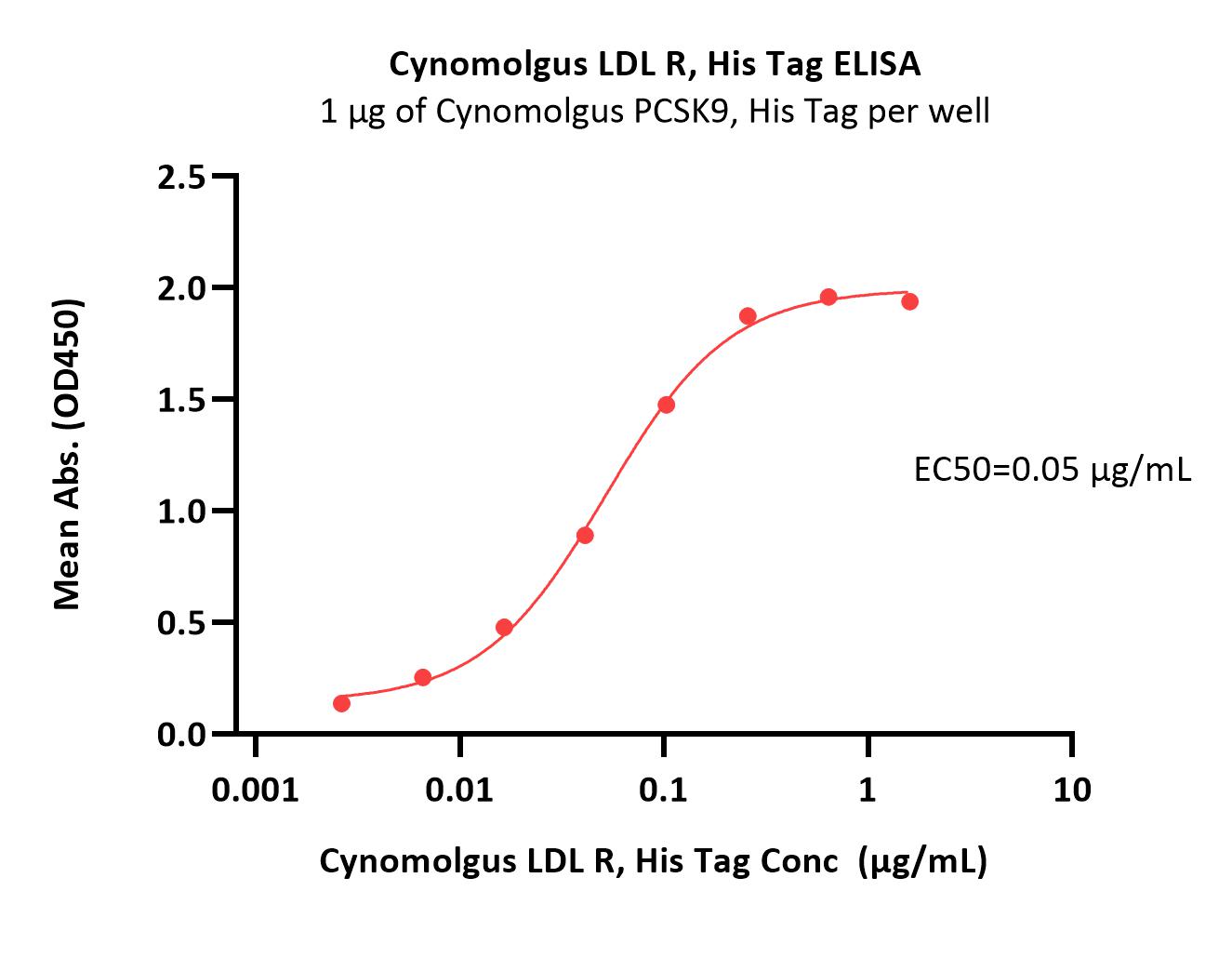分子别名(Synonym)
LDLR,FH,FHC,LDLCQ2
表达区间及表达系统(Source)
Cynomolgus LDL R, His Tag (LDR-C5222) is expressed from human 293 cells (HEK293). It contains AA Ala 22 - Gly 788 (Accession # XP_005588053.1).
Predicted N-terminus: Ala 22
Request for sequence
蛋白结构(Molecular Characterization)

This protein carries a polyhistidine tag at the C-terminus.
The protein has a calculated MW of 86.8 kDa. The protein migrates as 135-155 kDa under reducing (R) condition (SDS-PAGE) due to glycosylation.
内毒素(Endotoxin)
Less than 1.0 EU per μg by the LAL method.
纯度(Purity)
>95% as determined by SDS-PAGE.
制剂(Formulation)
Lyophilized from 0.22 μm filtered solution in PBS, pH7.4 with trehalose as protectant.
Contact us for customized product form or formulation.
重构方法(Reconstitution)
Please see Certificate of Analysis for specific instructions.
For best performance, we strongly recommend you to follow the reconstitution protocol provided in the CoA.
存储(Storage)
For long term storage, the product should be stored at lyophilized state at -20°C or lower.
Please avoid repeated freeze-thaw cycles.
This product is stable after storage at:
- -20°C to -70°C for 12 months in lyophilized state;
- -70°C for 3 months under sterile conditions after reconstitution.
电泳(SDS-PAGE)

Cynomolgus LDL R, His Tag on SDS-PAGE under reducing (R) condition. The gel was stained with Coomassie Blue. The purity of the protein is greater than 95%.
活性(Bioactivity)-ELISA

Immobilized Cynomolgus LDL R, His Tag (Cat. No. LDR-C5222) at 2 μg/mL (100 μL/well) can bind Biotinylated Human PCSK9, Avitag,His Tag (Cat. No. PC9-H82E7) with a linear range of 0.007-0.256 μg/mL (QC tested).
Protocol

Immobilized Cynomolgus PCSK9, His Tag (Cat. No. PC9-C5223) at 10 μg/mL (100 μL/well) can bind Cynomolgus LDL R, His Tag (Cat. No. LDR-C5222) with a linear range of 0.04-0.256 μg/mL (Routinely tested).
Protocol
活性(Bioactivity)-BLI

Loaded Human PCSK9, Fc Tag (Cat. No. PC9-H5256) on Protein A Biosensor, can bind Cynomolgus LDL R, His Tag (Cat. No. LDR-C5222) with an affinity constant of 1.24 nM as determined in BLI assay (ForteBio Octet Red96e) (Routinely tested).
Protocol
背景(Background)
Low-Density Lipoprotein (LDL) Receptor is also known as LDLR, FH, FHC, LDLCQ2, and is a mosaic protein of ~840 amino acids (after removal of signal peptide) that mediates the endocytosis of cholesterol-rich LDL. It is a cell-surface receptor that recognizes the apoprotein B100 which is embedded in the phospholipid outer layer of LDL particles. The receptor also recognizes the apoE protein found in chylomicron remnants and VLDL remnants (IDL). It belongs to the Low density lipoprotein receptor gene family. LDL receptor complexes are present in clathrin-coated pits (or buds) on the cell surface, which when bound to LDL-cholesterol via adaptin, are pinched off to form clathrin-coated vesicles inside the cell. This allows LDL-cholesterol to be bound and internalized in a process known as endocytosis and prevents the LDL just diffusing around the membrane surface. This occurs in all nucleated cells (not erythrocytes), but mainly in the liver which removes ~70% of LDL from the circulation. Synthesis of receptors in the cell is regulated by the level of free intracellular cholesterol; if it is in excess for the needs of the cell then the transcription of the receptor gene will be inhibited. LDL receptors are translated by ribosomes on the endoplasmic reticulum and are modified by the Golgi apparatus before travelling in vesicles to the cell surface. LDL is directly involved in the development of atherosclerosis, due to accumulation of LDL-cholesterol in the blood. Atherosclerosis is the process responsible for the majority of cardiovascular diseases.























































 膜杰作
膜杰作 Star Staining
Star Staining











